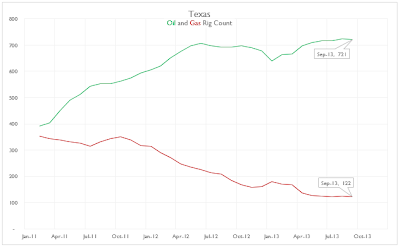The Texas Railroad Commission collects and reports oil and gas statistics, but their data is not close to finalized for many months, so recent production is typically understated. This has let some to wrongly conclude that production is in decline. The EIA uses a methodology for estimating unreported production, and their data is less subject to revision and more accurate for recent periods. Here is the monthly history since 2010 of the EIA data vs. the TX RRC data for natural gas production. Over time, the RRC number has averaged about 0.2 BCFD below the EIA estimate. But look at the current period:
So it seems that unless a new source of error has crept in, the RRC data is not reliable for close to a year.
It can be difficult to accurately assess oil vs gas activity levels in Texas, part because drilling permits can be one of three types:
- Oil
- Gas
- Oil & Gas
But well completions are classified as either oil or gas, not both. When a well completion is considered an oil completion, the production therefrom is classed as "Oil" and "Casinghead Gas". A gas well completion has production classified as "Gas Well Gas" and "Condensate".
To look strictly at oil wells, we see that the amount of casinghead gas produced with the oil has maintained a steady percentage as oil production has grown. Here is the %, on a BTU basis, of casinghead gas produced from oil wells 2010 to present:
This is a high associated gas content. It implies that even with a low gas rig count, a significant volume of natural gas will be produced as Texas oil production continues to rise.
Now total liquids is another point worth making. Here is how the RRC reports it, separating oil and condensate. (There is some discussion about the classification of the liquids coming out of the Eagle Ford.)




